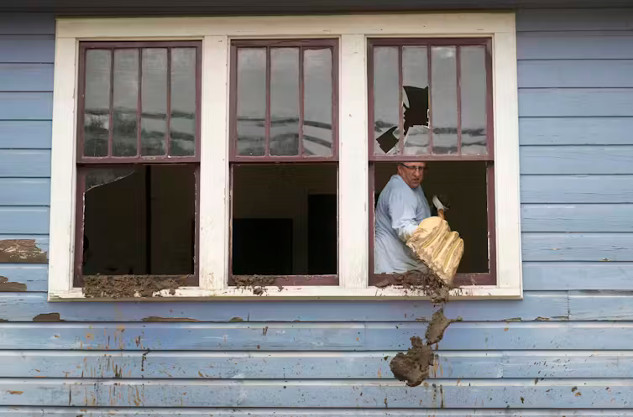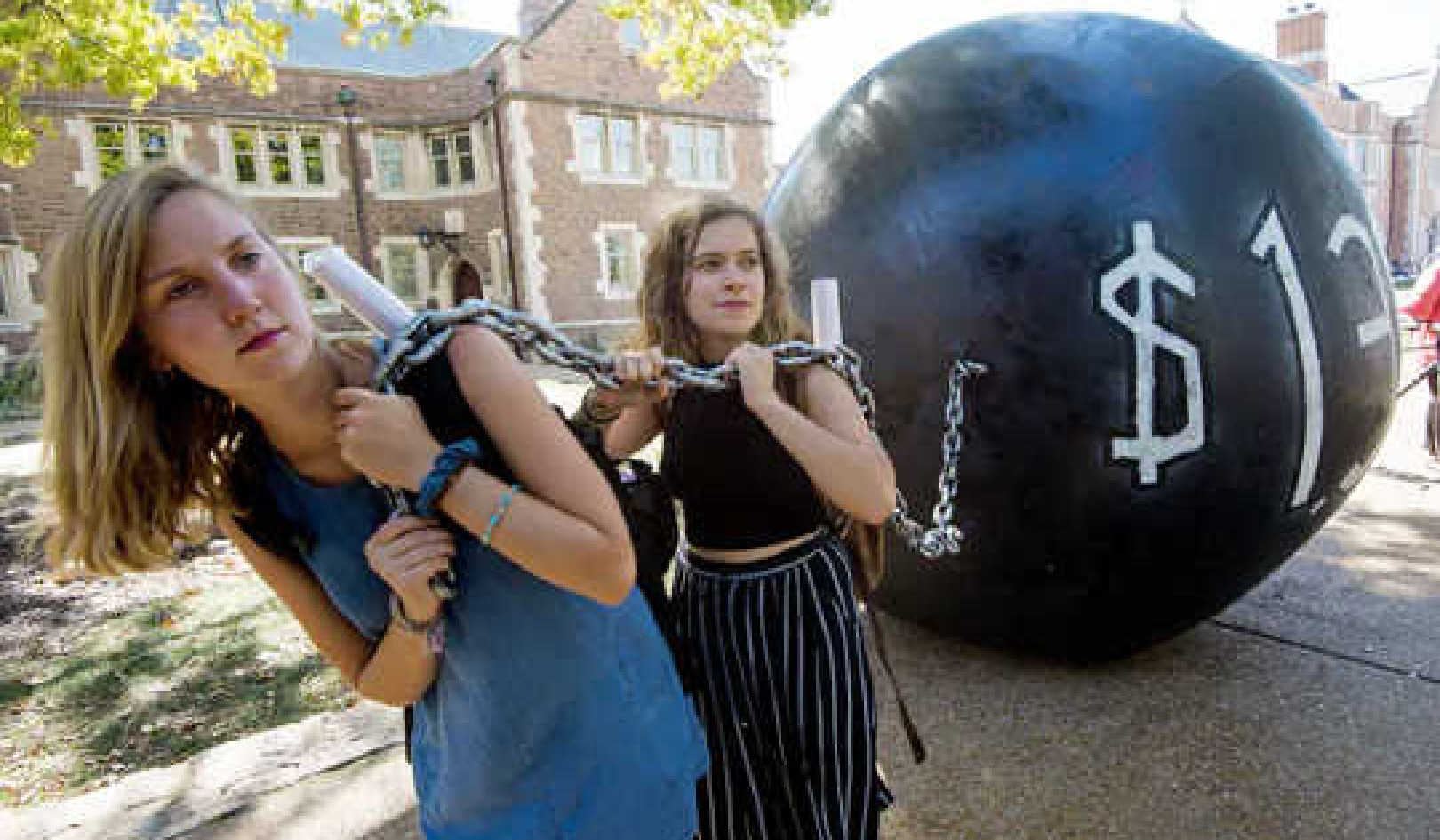
Hurricane Helene flooded homes with water and mud in Marshall, N.C. Many people will be out of their homes for months or longer. AP Photo/Jeff Roberson
In this Article:
- How does hurricane displacement affect health long-term?
- Why are some groups more vulnerable to disaster displacement?
- What mental health challenges arise post-disaster?
- How can policies support displaced individuals effectively?
- Understanding the role of power and clean water in recovery
How Disaster Recovery Policies Fail Vulnerable Groups
by Trevor Memmott and Christian Weller, UMass Boston
For many people, being displaced by a disaster has long-term consequences that often aren’t obvious or considered in disaster aid decisions.
We study public policy and disaster response. To get a better understanding of the ongoing challenges disaster victims face – and how officials can respond more effectively – we analyzed U.S. Census Bureau surveys that ask people nationwide about their disaster displacement experiences, as well as their stress and anxiety.
The results show how recovery from disasters such as hurricanes, wildfires, tornadoes and flooding involves more than rebuilding, and how already vulnerable groups are at the greatest risk of harm.
Millions are displaced every year
The Census Bureau’s Household Pulse Survey has been continually collecting data on people’s social and economic experiences since 2020. Since late 2022, it has specifically asked respondents whether they had been displaced from their homes because of natural disasters.
Nearly 1.4% of the U.S. adult population reported being displaced in the previous year, equating to more than 3 million Americans. The most common cause of those displacements was hurricanes, responsible for nearly one-third of the displacements.
Some groups faced a higher chance of being displaced by a natural disaster than others.
The likelihood of displacement was above average for people with incomes of less than $50,000 (1.9% of that population was displaced), disabled people (2.7%), African Americans (2.3%) and Latinos/Hispanics (1.8%), as well as for those who identified their sexual orientation as gay/lesbian, bisexual, something else, or said that they don’t know (2.2%).
The problems of displacement go beyond immediate evacuation. People may have to stay in temporary shelters such as stadiums, churches or disaster relief areas. During this time, they are likely unable to work and earn income. Others with nowhere else to go may return to still-damaged homes after the storm passes.
Many people who were displaced by a hurricane faced weeks without power or lacked access to enough food, clean water or other basic necessities. After being displaced, 64% of adults said they lacked electricity some or all of the time, 37% lacked enough food, 29% lacked drinkable water, and 25% indicated that they experienced unsanitary conditions some or all of the time.
Going without enough clean water or electricity can expose people to diseases and other health risks, on top of the stress of dealing with the damage, displacement and uncertainty about the future.
About 36% of those displaced were out of their homes for more than one month. Nearly 16% of them indicated that they never were able to return. Vulnerable groups, especially people of color and disabled people, were least likely to return home quickly.
Impacts on health
Being displaced also piles on stress and creates instability. People displaced by storms may bounce among family members’ houses, hotel rooms or even vehicles as they wait to return to a home that has been damaged. They may have lost jobs or be unable to find temporary housing nearby, creating feelings of uncertainty about the future.
People who feel that their safety or security is threatened are more likely to experience mental stress and, potentially, post-traumatic stress disorder. The effects can accumulate over time and have long-term health consequences. Chronic stress can contribute to hypertension and heart disease and make rebuilding lives even harder as people struggle with more than just the damage around them.
The Household Pulse Survey also collects information on the symptoms of anxiety and depression that individuals experience.
Among those who have been displaced by a hurricane, 38% indicated experiencing generalized anxiety, a much higher percentage than the 23% of the population who did not experience displacement.
Similarly, 33% of those who were displaced experienced symptoms of major depressive disorder compared with 18% of the population who did not face displacement.
Better policies for long-term recovery
The survey results highlight the need to restore water and power to homes quickly after disasters. The results also point to prioritizing communities that are least able to afford being displaced.
Studies have shown that low-income communities often wait longest for power to be restored after hurricanes. The survey shows that these communities and other disadvantaged groups also face higher levels of displacement after disasters.
Beyond the immediate responses to a disaster, the survey suggests that federal, state and local policymakers will have to consider long-term assistance for both housing recovery and for health care.
Currently, the Federal Emergency Management Agency primarily focuses on providing short-term disaster relief. The large majority of its disaster funding goes toward evacuation, temporary shelter for people displaced, emergency supplies, insurance and rebuilding community infrastructure. While other federal programs provide rebuilding assistance for individuals, they don’t sufficiently address the long-term challenges, in our view.
Some ways government could help include providing targeted cash transfers to ensure vulnerable households can rebuild, investing in affordable and climate-resilient housing that can limit losses in future disasters, and funding long-term mental health services for disaster survivors at free or reduced cost.
As the climate warms, extreme storms are becoming more common in every region of the country. That’s raising the risks and the need for policymakers to prepare communities to limit harm from disasters and recover afterward. We believe rebuilding lives will require support long term, both for building more resilient homes and infrastructure and for recovering from the trauma.![]()
Trevor Memmott, Assistant Professor of Policy and Public Affairs, UMass Boston and Christian Weller, Professor of Public Policy and Public Affairs, UMass Boston
Article Recap:
Hurricane displacement not only displaces millions but also has long-lasting health effects, particularly impacting vulnerable populations. Research highlights higher rates of anxiety and depression among displaced individuals, often compounded by extended power and water outages. Current policies largely address immediate needs but lack sustained support for health and housing recovery. Smarter, targeted policies, like prioritizing power restoration and mental health resources, could help reduce these long-term impacts.
This article is republished from The Conversation under a Creative Commons license. Read the original article.

Related Books:
The Future We Choose: Surviving the Climate Crisis
by Christiana Figueres and Tom Rivett-Carnac
The authors, who played key roles in the Paris Agreement on climate change, offer insights and strategies for addressing the climate crisis, including individual and collective action.
Click for more info or to order
The Uninhabitable Earth: Life After Warming
by David Wallace-Wells
This book explores the potential consequences of unchecked climate change, including mass extinction, food and water scarcity, and political instability.
Click for more info or to order
The Ministry for the Future: A Novel
by Kim Stanley Robinson
This novel imagines a near-future world grappling with the impacts of climate change and offers a vision for how society might transform to address the crisis.
Click for more info or to order
Under a White Sky: The Nature of the Future
by Elizabeth Kolbert
The author explores the human impact on the natural world, including climate change, and the potential for technological solutions to address environmental challenges.
Click for more info or to order
Drawdown: The Most Comprehensive Plan Ever Proposed to Reverse Global Warming
edited by Paul Hawken
This book presents a comprehensive plan for addressing climate change, including solutions from a range of sectors such as energy, agriculture, and transportation.
Click for more info or to order






















